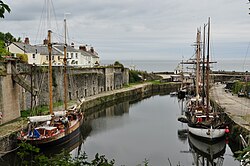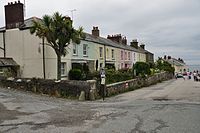Charlestown, Cornwall
| Charlestown | |
| Cornwall | |
|---|---|
 Charlestown Hharbour | |
| Location | |
| Grid reference: | SX037516 |
| Location: | 50°19’53"N, 4°45’28"W |
| Data | |
| Post town: | St Austell |
| Postcode: | PL25 |
| Dialling code: | 01726 |
| Local Government | |
| Council: | Cornwall |
| Parliamentary constituency: |
St Austell and Newquay |
Charlestown is a village and port on the south coast of Cornwall just south of the county's largest town, St Austell, but not swallowed by it and maintaining its own, Georgian and Victorian appearance. It is within the civil parish of St Austell Bay and two miles south-east of St Austell town centre.
The port at Charlestown developed in the late-18th century from the fishing village of West Polmear (a name from the Cornish Porth Meur, meaning "great cove"). While other areas of St Austell have seen much development during the 20th century, Charlestown has remained relatively unchanged.
History

Charlestown grew out of the small fishing village of West Polmear (or West Porthmear), which consisted of a few cottages and three cellars, in which the catch of pilchards]] were processed. The population amounted to nine fishermen and their families in 1790.[1] Before the harbour was built, trading vessels landed and loaded on the beach.[2]
Charles Rashleigh who moved to Duporth Manor, just outside the village, used plans prepared by John Smeaton to begin the construction of a harbour and dock in 1791. After building the outer pier, he excavated a natural inlet to form the main dock and a shipyard at its inner end that demolished when the dock was extended.[3] The first dock gates were completed in 1799. To maintain water levels in the dock, a leat was constructed, which brought water from the Luxulyan Valley, some four miles away.[4]
Rashleigh also planned the village, which had a broad road running from the harbour to Mount Charles.[5] In 1793, a gun battery was built to the west of the harbour mouth, as a defence against possible French attacks. Volunteers from Rashleigh's estate formed an artillery company that lasted until 1860, when the original four 18-pound cannons were replaced by 24-pound models.[5] The Crinnis Cliff Volunteers became the Cornwall Artillery Volunteers, and the battery continued to be used for practice until 1898.[1]
In 1799 the men of the village asked Rashleigh's permission to rename the place 'Charles's Town' after him, which became Charlestown.
The port was built to facilitate the transport of copper from nearby mines. Crinnis Hill Mine to the east of the village exported some 40,000 tons of copper ore between 1810 and 1813. South Polmear Mine to the west and Charlestown United Mines operated from a site near Holmbush to the north. This enterprise was particularly prolific, employing 431 men, 120 women and 263 children in 1838.[6] The 1851 census recorded 283 adults living in Holmbush, of whom ten were employed as miners and one was the mine agent. As the mines became exhausted and their output dropped, the port was used to export china clay from the region's quarries.[7]
Following the death of Charles Rashleigh in 1823 the fate of Charlestown was caught up in the financial problems of his estate. Joseph Dingle, once a servant and footman employed by Rashleigh, became superintendent of works when the construction of the harbour began, but had systematically embezzled money from the project. By the time the case reached the courts in 1811, he was thought to have embezzled around £32,000. Dingle was bankrupted and died a pauper; Rashleigh also was made bankrupt before his death.[8] In 1825 Messrs Crowder and Sartoris, trading as Charlestown Estate, agreed to accept all the leasehold property in Charlestown in lieu of sums owed to them and purchased the rest of the estate from the Rashleigh family becoming the new owners of the port and the surrounding settlement.
Despite competition from the port at Pentewan, which opened in 1826, and from Par, which opened shortly afterwards, Charlestown prospered from the rapid expansion in the export of china clay until the onset of the First World War.[9] By 1911, its population had increased to 3,184.
The harbour was designed for small sailing vessels, and an awkward turn was required to avoid the protruding end of the outer harbour.[10] Following the widening of the entrance and the fitting of new gates in 1971, ships of up to 600 tons were able to enter the harbour,[11] but could only do so at high tide, and a system of ropes was used to manoeuvre vessels through the gates. By the 1990s, the size of vessels used for the transport of china clay had outgrown the harbour, and the last commercial load of clay to leave Charlestown did so in 2000.[10] Exports of china clay left Cornwall through Par or the deep water port at Fowey instead.[12]
In 1994 the harbour was bought by Square Sail as a base for their sailing ships.[13] Much of Square Sail's business involves using the harbour and their ships as film sets, such as the 2015 television series Poldark .
Economy
Charlestown harbour is used by local fishermen. It is owned by Square Sail, a company that owns and sails a small fleet of tall ships, including Kaskelot. One or two tall ships can often be found at anchor in the harbour. The best-known tall ship to regularly visit the port was the Maria Asumpta, first launched in 1858 and the world's oldest working square rigger. The Maria Asumpta ran aground and broke up on the north Cornish coast in May 1995, with the loss of three of her sixteen crew.
In July 2012 Robin Davies, the owner of Square Sail and the harbour offered his business for sale for £4.4 million,[14] made up of £1.5 million for the harbour, £1.4 million for Square Sail's assets, and another £1.5 million for adjacent land.[15]
Charlestown is a tourist destination. Attractions are the architecture, the sea, and the Charlestown Shipwreck, Rescue and Heritage Centre which has also been put up for sale due to the retirement of the long-time owner.[16] The village Pier House Hotel is by the harbour. The Rashleigh Arms public house is by the harbour. The post office closed without a replacement and the village has a gift shop, the Bosun's Diner and several other eating establishments in and around the harbour.
Churches

A Methodist Chapel was built in 1827,[7] and continued in use until 2000, when it closed and was sold. In 2012, the structure was in a poor state of repair and causing concern because it is within a World Heritage Site.[17] Both the chapel and the attached schoolrooms are Grade II* listed.[18]
The parish of Charlestown was created in 1846 by the Diocese of Exeter when the population of the village was about 3,000 people. It was split from the parish of St Austell, and land was given for a church in 1848 by George Augustus Crowder, the managing director of Charlestown Estates. Construction of St Pauls Church began the following year and was completed in 1851.[19] It was designed by Christopher Eales, and has a nave and chancel with transepts and north and south aisles. It is constructed of rubble with granite dressings. The tower at the western end did not have a spire until 1971, when a glass-reinforced plastic structure was added. The south aisle has late-19th century stained glass memorials to five local families. The church has been Grade II listed since 1999.[20]
Charlestown on film

The Georgian charm of Charlestown Harbour has ensured that it has frequently been used as a filming location for both film and television dramas. These include:
- Tim Burton's Alice in Wonderland (2010, filmed here in 2008)[21]
- Doctor Who (filmed 1 February 2011)[22] Much of the episiode, The Curse of the Black Spot, was filmed at night on the Phoenix of Dell Quay moored in the harbour.[23]
- The Adventurer: The Curse of the Midas Box, filmed in 2012.[24]
- Poldark (BBC, 2015).[25]
Sport
- Charlestown Rowing Club
Pictures
-
The first beach is separated from the other...
-
...by the harbour entrance and outer harbour...
-
The impounded harbour
-
... as the tide went out, August 2001
Outside links
| ("Wikimedia Commons" has material about Charlestown, Cornwall) |
References
- ↑ 1.0 1.1 Larn & Larn 2006, p. 5.
- ↑ Larn & Larn 2006, p. 3.
- ↑ Hancock 2008, pp. 53-54.
- ↑ Fogg 2011, p. 89.
- ↑ 5.0 5.1 Hancock 2008, p. 54.
- ↑ Hancock 2008, pp. 55-56.
- ↑ 7.0 7.1 Hancock 2008, p. 56.
- ↑ Larn & Larn 2006, p. 7.
- ↑ Larn & Larn 2006, pp. 8-9.
- ↑ 10.0 10.1 Fogg 2011, pp. 89-90.
- ↑ Larn & Larn 2006, p. 9.
- ↑ Fogg 2011, p. 95.
- ↑ "Charlestown Harbour". Square Sail. http://www.square-sail.com/harbour/. Retrieved 13 June 2014.
- ↑ "Charlestown harbour on sale for £4.4m". BBC. 13 July 2012. http://www.bbc.co.uk/news/uk-england-cornwall-18811158.
- ↑ "For Sale". First Peninsula Marine. http://www.firstpeninsulamarine.co.uk/charlestownharbour/. Retrieved 19 June 2014.
- ↑ Fogg 2011, p. 88.
- ↑ "Eyesore chapel deteriorating daily". Cornish Guardian. 21 December 2012. http://www.cornishguardian.co.uk/Eyesore-chapel-said-deteriorating-daily/story-17647167-detail/story.html.
- ↑ National Heritage List 1144292: Wesleyan Chapel and attached schoolrooms
- ↑ Information on Charlestown, Cornwall from GENUKI
- ↑ National Heritage List 1379464: Church of St Paul
- ↑ Alice in Wonderland (2010) - locations on the Internet Movie Database
- ↑ Dr Who is filmed in Charlestown – BBC News, 4 February 2011
- ↑ Mulkern, Patrick (7–13 May 2011). "Who ahhhhh!". Radio Times (BBC Magazines) 349 (4539): 6–7.
- ↑ The Adventurer: The Curse of the Midas Box - locations on the Internet Movie Database
- ↑ Poldark (2015) - locations on the Internet Movie Database
Books
- Fogg, Roger (2011). Cornwall's China Clay Country. Halsgrove. ISBN 978-0-85704-103-6.
- Hancock, Peter (2008). The Mining Heritage of Cornwall and West Devon. Halsgrove. ISBN 978-1-84114-753-6.
- Larn, Richard; Larn, Bridget (1994). Charlestown - the history of a Cornish Seaport. Shipwreck & Marine. ISBN 978-0-9523971-0-6.
- Larn, Richard; Larn, Bridget (2006). Charlestown. Tor Mark Press. ISBN 978-0-85025-350-4.




